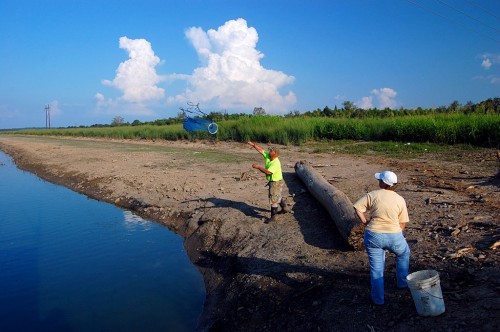 After seeing that the flooding had gone down, I decided to drive down Old Highway 61 that parallels I-55 south of Sprigg Street and ends at a boat ramp. After taking a scenic photo, I noticed a couple throwing a cast net. [Click on any photo to make it larger.]
After seeing that the flooding had gone down, I decided to drive down Old Highway 61 that parallels I-55 south of Sprigg Street and ends at a boat ramp. After taking a scenic photo, I noticed a couple throwing a cast net. [Click on any photo to make it larger.]
Aerial of Diversion Channel
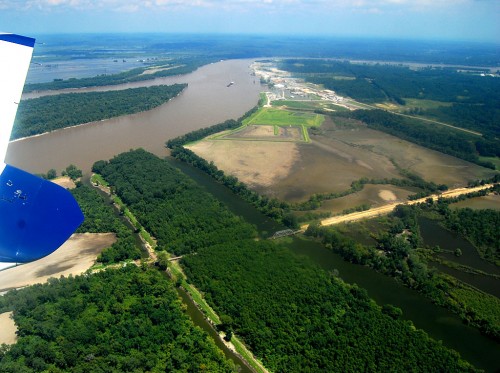 Ed and Melinda Roberts of Jackson were trying to snag enough bait to put out two trotlines where the Mississippi River meets up with the ditch that is just north of the Diversion Channel. Ed Calls it the North Cut Ditch. I’ve heard it called the Little Ditch and at least one topographic map labels it the Dutchtown Ditch.
Ed and Melinda Roberts of Jackson were trying to snag enough bait to put out two trotlines where the Mississippi River meets up with the ditch that is just north of the Diversion Channel. Ed Calls it the North Cut Ditch. I’ve heard it called the Little Ditch and at least one topographic map labels it the Dutchtown Ditch.
I was able to snap a picture of the Diversion Channel and the North Cut from the Cape Air Flight I was on. The Channel is on the right, the larger of the two canals.
“It’s all about stuffing the freezer”
Ed is a guy who fishes for the fun of eating fish. “I hope to have 400-500 pounds of fish in the freezer before the season is over. It’s all about stuffing the freezer.” Most of them will be channel catfish or blue cats. His biggest catch was an 82-pound blue on a trotline. “I WISH I had caught it on a rod.”
Enough bait to do the job
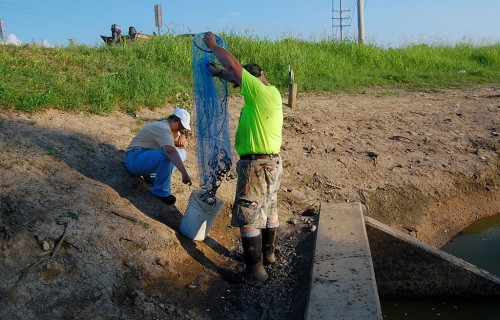 The water was boiling with fish, mostly gars, which the couple tossed up on the bank to join dozens more. “Most of them were killed by bow hunters,” he said. After about half a dozen casts, he brought up enough bait to do the job.
The water was boiling with fish, mostly gars, which the couple tossed up on the bank to join dozens more. “Most of them were killed by bow hunters,” he said. After about half a dozen casts, he brought up enough bait to do the job.
Heat killed many fish
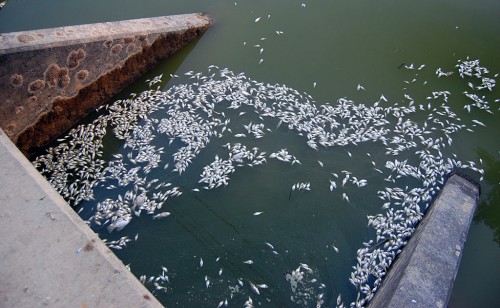 “I’ve never seen shad die like this in the summertime. It’s the heat that’s killing them,” he explained. The hot water also limits how deep he can set his lines.
“I’ve never seen shad die like this in the summertime. It’s the heat that’s killing them,” he explained. The hot water also limits how deep he can set his lines.
Nature’s cleanup crew
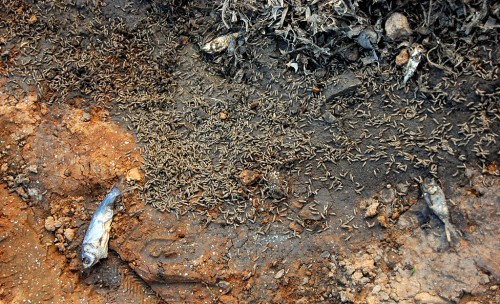 Maggots are hard at work cleaning up anything edible left behind by the flood and fishermen. “It’s a good thing,” Ed said.
Maggots are hard at work cleaning up anything edible left behind by the flood and fishermen. “It’s a good thing,” Ed said.
Launching the boat
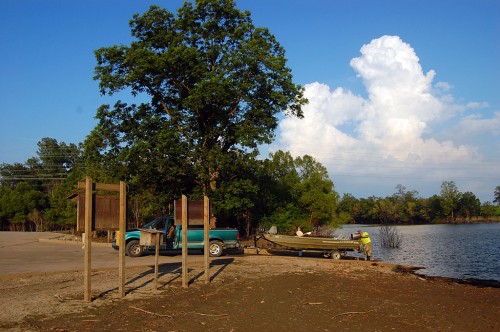 When I asked if I could follow them down to where they was going to put the boat in the water, ED offered me something better: a ride to watch them put out the lines.
When I asked if I could follow them down to where they was going to put the boat in the water, ED offered me something better: a ride to watch them put out the lines.
Video: how to set out a trotline
Here’s your opportunity to see how to set out a trotline.
Motor wasn’t running right
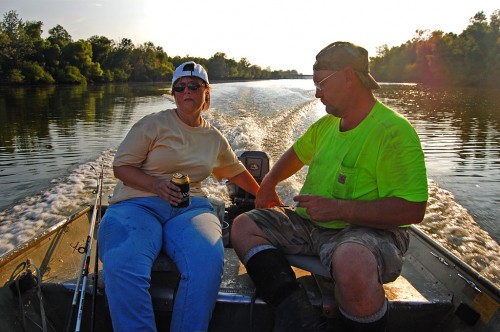 When we started out, the motor was missing and sputtering. I wondered if they had invited me along to be a galley slave if the engine conked out. Ed assured me that wasn’t the case. He said that a plug was fouled and he wouldn’t go far from the ramp until he had it cleared.
When we started out, the motor was missing and sputtering. I wondered if they had invited me along to be a galley slave if the engine conked out. Ed assured me that wasn’t the case. He said that a plug was fouled and he wouldn’t go far from the ramp until he had it cleared.
Headed out the Diversion Channel
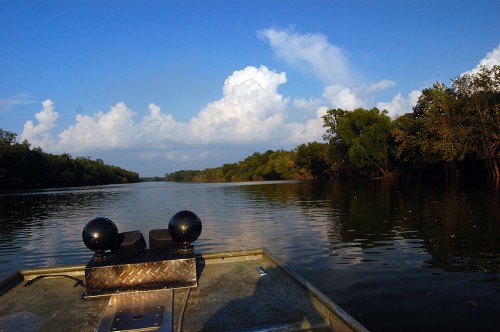 Before long, we were headed out the Diversion Channel to meet the Mississippi River. I’ll run scenic shots from the ride another day. I always thought of the Channel as a sterile ditch, but it’s a beautiful waterway with interesting trees on both sides.
Before long, we were headed out the Diversion Channel to meet the Mississippi River. I’ll run scenic shots from the ride another day. I always thought of the Channel as a sterile ditch, but it’s a beautiful waterway with interesting trees on both sides.
Northbound on the Mississippi
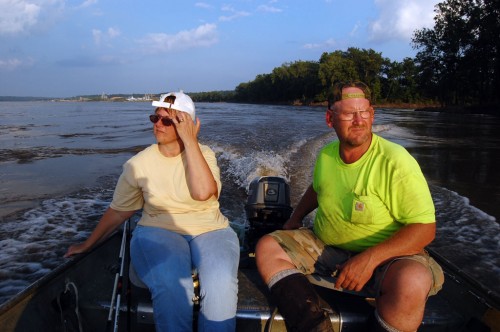 Before long, we were northbound on the river. The boat felt a lot smaller out there.
Before long, we were northbound on the river. The boat felt a lot smaller out there.
Checking out the motor
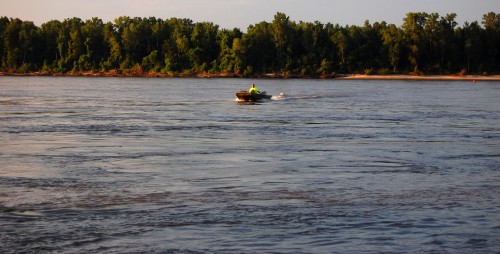 When we got to where he was going to set his lines, he still wasn’t happy with the way the motor was running, so he left Melinda and me on the bank while he did a high-speed run in the river until he was satisfied.
When we got to where he was going to set his lines, he still wasn’t happy with the way the motor was running, so he left Melinda and me on the bank while he did a high-speed run in the river until he was satisfied.
Baiting the hooks
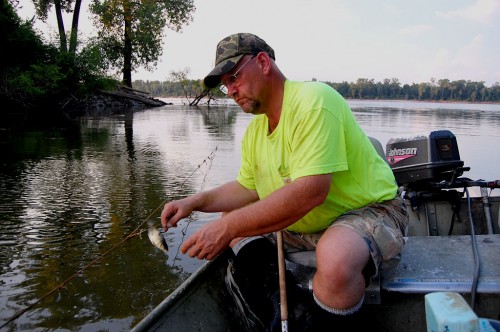 I couldn’t shoot both stills and video at the same time, so you’ll have to watch the video if you want to see what’s involved in setting a trotline. Here he is baiting one of the hooks with a fish he caught when we first met. If he’s in the river, he’s permitted to have 50 hooks; if he’s fishing in the ditches, he can have a maximum of 33.
I couldn’t shoot both stills and video at the same time, so you’ll have to watch the video if you want to see what’s involved in setting a trotline. Here he is baiting one of the hooks with a fish he caught when we first met. If he’s in the river, he’s permitted to have 50 hooks; if he’s fishing in the ditches, he can have a maximum of 33.
Getting close to sunset
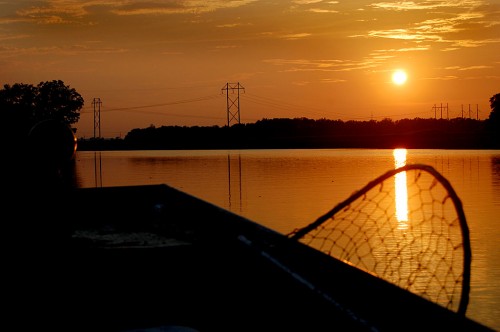 Ed was starting to run out of daylight, so he decided not to set out both lines. When we pulled into the bank, I asked what time the mosquitoes would show up. “I’ve got pepper spray, so I can hold ’em off for a little while while you make a run for it,” I offered.
Ed was starting to run out of daylight, so he decided not to set out both lines. When we pulled into the bank, I asked what time the mosquitoes would show up. “I’ve got pepper spray, so I can hold ’em off for a little while while you make a run for it,” I offered.
Ed and Melinda assured me that they had plenty of bug repellent, but Ed said he’d run me back to the ramp before it got dark. They planned to stay a good part of the night running the line about every two hours and fishing with a rod and reel in the meantime.
It was a great experience. There’s a lesson here: you sure meet some nice people if you just get out of your steel cage from time to time and talk to the folks you come across. When I woke up that morning, I never dreamed that I’d end the day in a small boat on the Mississippi River.

What a great experience! I learned a few things. I never spent any time on the Diversion channel but some of my friends liked to shoot gars. I hope you have more aerials of the area south to Scott City and north to the cement plant. It is amazing how the area has changed.
Bill,
Did you see the aerial I posted of the cement plant quarry in the 60s and last fall?
A piece I did on a 1929 railroad bridge across Cape LaCroix Creek had an aerial of the south end of Smelterville. (I’m working on a major piece on Smelterville that will run in the next few months. I’m trying to track down some of the people I shot back in 1967.)
I have lots of aerials of that area, but I don’t like to run too many at one time. Some folks (like me) love to pore over them; other people couldn’t care less.
Here’s an old shot of the Scott City I-55 interchange being built.
Great story. I spent lots of time with my Dad and a good family friend (Pete Mienz) running trout lines on the big ditch. Caught our own bait with a seine and had problems with the boat motor also. Caught lots of catfish and gars. Not sure of the exact date, but I remember coming off the ditch, going to Pete’s house to fry some fish, and watch the heavy wight fight between Sony Liston and (?). Liston went down in the first minute of the fight. Had lots to talk about after that. Was the fight fixed?
Love your site and all the Cape memories.
I’m a videographer and interested in how you captured the video. Was it on a camcorder or the video function of a still camera?
I shot it with an inexpensive Canon FS100. The audio was captured by the camera’s mike, although I did have a digital recorder with an external mic on my shooting vest for backup.
Since I’ve been shooting picture stories for decades, I thought the transition to video would easy since the elements are pretty much the same. Shoot a beginning, middle and the end; make sure you have a few wideangle establishing shots, some medium shots and a closeup or two.
What I hadn’t counted on was how hard it is to get good, clean audio. If I win the lottery, my next purchase will be a good wireless mic.
The camera was originally purchased for my bike blog. Here’s an example of how I mount front and rear-facing cameras on the bike.
Here’s an example of a video that made extensive use of the front-and-rear viewpoints. It was designed to show as many riders as possible, so it’s about four times as long as I’d make it for general audiences.
The story about Bill’s transition to Jacqie was my most ambitious project in terms of boiling about two hours of interviews.
As a videographer, I’m definitely a work in progress.
I had to smile about the audio comment. So true.
Thanks for the other links also.
Great post, today. I always wanted to know how trotlines were set out.
Great Video, even the wife loved it!…She wants to see a video of what they caught!
Nice work Dude!
I never was on the Diversion Channel…but it looks very cool…I remember the fight that Steve Saw with Mohammed Ali and Sonny Liston and the myster punch that floored Liston…great fight. A lot of money changed hands that night!
Great capture of Life on the Mississippi. wait, what a great title maybe you should name your adventures “Life on the Mississippi”…What do you think?
I was hoping nobody would notice that I was missing that detail.
I didn’t object when Ed offered to take me back to the ramp at sunset because (a) I didn’t bring a flash with me, (b) I was getting hungry and (c) I wasn’t sure if mosquitoes would see pepper spray as a repellent or as seasoning.
“Life on the Mississippi” is a great title. Wonder if anyone else has used it?
I just Googled “Life on the Mississippi,” and apparently Mark Twain beat you to it.
I enjoy this blog, much to my surprise. I didn’t think I’d like reading about an area that’s totally foreign to me, but as always, you come up with interesting stories and photos.
But I miss the lack of entries on your bike blog. Seems like you’re almost busier in retirement than when you were officially working.
That darned Mark Twain. Isn’t he famous enough without snatching up all the good titles?
I cross-posted this story on the bike blog, so don’t get excited when you see that there’s new content.
When I was working in Ohio, I produced five photo essays a week. I’m doing at least six or seven on Cape every week, so, yes, I AM working harder than when I was working. Glad you’re enjoying the stories.
Great story and great video. Folks on the river are some of the most interesting people you meet. I remember interviewing an old fellow who ran the boat dock on Dacus Lake, an oxbow lake on the Arkansas side of the Mississippi River from Memphis. He was a great guy to talk to and to quote.
I don’t check my e-mail very often any more. Just saw your story on us and enjoyed it very much!
We should have invited you to come back in the morning to run the lines. Maybe we can arrange something if you ever get back this way. We caught about 12 fish all together and a combined weight of 170 pounds. The largest was a blue cat that weighed in excess of 40 lbs.
my dad granddad ran a trotline on the Coal River when I was a kid. We had lots of catfish and snapping turtle soup. No kidding. We used rotten chicken pieces (from Mother’s chicken butchering). In China we came to like chicken feet; to think how many we wasted on bait… So can you take me trotline fishing? I always wondered if trotline was really supposed to be trout line, but with so much coal dust in the river the trout all died.
just sayn hi Ed , had no idea u trot lined lol well if u even remember gimme a shout , stacy
great website and on topic